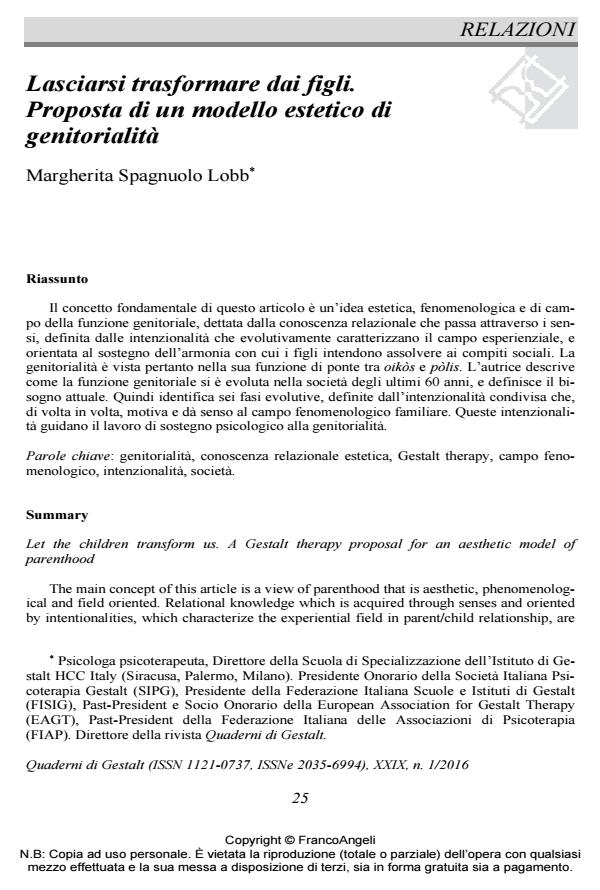Let the children transform us. A Gestalt therapy proposal for an aesthetic model of parenthood
Journal title QUADERNI DI GESTALT
Author/s Margherita Spagnuolo Lobb
Publishing Year 2017 Issue 2016/1 Language Italian
Pages 15 P. 25-39 File size 212 KB
DOI 10.3280/GEST2016-001003
DOI is like a bar code for intellectual property: to have more infomation
click here
Below, you can see the article first page
If you want to buy this article in PDF format, you can do it, following the instructions to buy download credits

FrancoAngeli is member of Publishers International Linking Association, Inc (PILA), a not-for-profit association which run the CrossRef service enabling links to and from online scholarly content.
The main concept of this article is a view of parenthood that is aesthetic, phenomenological and field oriented. Relational knowledge which is acquired through senses and oriented by intentionalities, which characterize the experiential field in parent/child relationship, are the tools of this model, which is aimed to support the harmonic involvement of children in society. Parenthood functions as a bridge between home (Oikòs) and society (Pòlis). The author describes how parental functions have developed in society and identifies six phases in the development of parent/child relationships. These phases are defined by the experience of shared intentionality in the field. In clinical practice, these intentionalities in the field lead the therapeutic support of families and parental couples.
Keywords: Parenthood, aesthetics relational knowledge, Gestalt therapy, phenomenological field, intentionality, society.
- Beebe B., Lachmann F.M. (2002). Infant Research and Adult Treatment: Co-constructing Interactions. New York: The Analytic Press (trad. it.: Infant Research e trattamento degli adulti. Un modello sistemico diadico delle interazioni. Milano: Raffaello Cortina Editore, 2003).
- Fivaz-Depeursinge E., Corboz-Warnery A. (1998). The Primary Triangle. New York: Basic Books (trad. it.: Il triangolo primario. Milano: Raffaello Cortina Editore, 1999).
- Galimberti U. (1999). Psiche e techne. L’uomo nell’età della tecnica. Milano: Feltrinelli.
- Galimberti U. (2008). Le cose dell’amore. Milano: Feltrinelli.
- Lévinas E. (2002). Dall’altro all’io. Roma: Meltemi editore.
- Mitchell S. (2000). Relationality: From Attachment to Intersubjectivity. New York: Analytic Press.
- Perls F. (1942;1947;1969). Ego, Hunger and Aggression: A Revision of Freud’s Theory and Method. London: G. Allen & Unwin, 1947; New York: Random Hause, 1969 (trad. it.: L’Io, la fame e l’aggressività. Milano: FrancoAngeli, 1995).
- Perls F., Hefferline R., Goodman P. (1971; 1997). Terapia e pratica della terapia della Gestalt. Vitalità e accrescimento nella personalità umana. Roma: Astrolabio (ed. or.: Gestalt Therapy. Excitement and Growth in the Human Personality. New York: The Gestalt Journal Press, 1951; 1997).
- Spagnuolo Lobb M. (2011). Il now-for-next in psicoterapia. La psicoterapia della Gestalt raccontata nella società post-moderna. Milano: FrancoAngeli.
- Spagnuolo Lobb M. (2013). Il corpo come “veicolo” del nostro essere nel mondo. L’esperienza corporea in psicoterapia della Gestalt. Quaderni di Gestalt, XXVI, 1: 41-65. DOI: 10.3280/GEST2013-00100
- Spagnuolo Lobb M., Salonia G. (1986). Al di là della sedia vuota: un modello di co-terapia. Quaderni di Gestalt, 3: 11-35 (relazione presentata all’VIII Congresso Internazionale di Psicoterapia della Gestalt, Cape Cod, Massachusetts, 16-18 Maggio).
- Spagnuolo Lobb M., Salonia G., Sichera A. (1996). From the “Discomfort of Civilization” to “Creative Adjustment”: the Relationship Between Individual and Community in Psychotherapy in the Third Millennium. International Journal of Psychotherapy, 1, 1: 45-53 (trad. it.: Dal “disagio della civiltà” all’“adattamento creativo”: il rapporto individuo/comunità nella psicoterapia del terzo millennio. In: Spagnuolo Lobb M., a cura di, Psicoterapia della Gestalt. Ermeneutica e clinica. Milano: FrancoAngeli, 2001, 180-190; Quaderni di Gestalt, 1997, 24/25: 95-105).
- Stern D.N. (2006). L’implicito e l’esplicito in psicoterapia. In: Spagnuolo Lobb M., a cura di, L’implicito e l’esplicito in psicoterapia. Atti del Secondo Congresso della Psicoterapia Italiana. DVD allegato, Milano: FrancoAngeli, 28-35.
- Stern D.N., Bruschweiler-Stern N., Harrison A., Lyons-Ruth K., Morgan A., Nahum J., Sander L., Tronick E. (2000). Lo sviluppo come metafora della relazione. Quaderni di Gestalt, XX, 30/31: 6-21.
- Le ‘maintenant-pour-l’ensuite’ Margherita Spagnuolo Lobb, Joseph Caccamo, in Cahiers de Gestalt-thérapie /2018 pp.58
DOI: 10.3917/cges.039.0058
Margherita Spagnuolo Lobb, Lasciarsi trasformare dai figli. Proposta di un modello estetico di genitorialità in "QUADERNI DI GESTALT" 1/2016, pp 25-39, DOI: 10.3280/GEST2016-001003